Lift, Flick, Claw - the art of smooth pedalling
Over the years I’ve watched a lot of cycling and done a whole lot more. For a long time I’ve been fascinated by the concept of ‘smoothness’ and what it really means. Why do some riders make cycling look so effortless and others make it look so difficult? Why do some riders look so powerful and some so weak?
This page contains some of my observations and my thoughts on how best to pedal. I make no claims that this is anything new or (excuse the pun) revolutionary - or that doing this LFC stuff will boost your power and shave minutes off your PBs.
Ankling
I remember articles about ‘ankling’ from my earliest cycling books and magazines but they certainly didn’t tell me the whole story. My first experiences of cleats & then clipless pedals didn’t help me in the short term either, and nowadays I frequently find myself making drastic adjustments to both new cyclists riding with their feet held (in toe clips or ‘clipless’ pedals) for the first time and to 'experienced' cyclists still riding with the cleat placement that they first happened upon when they started out.
It’s a pretty widely held belief that efficient pedalling is synonymous with pedalling in circles – somehow forcing the pedal forwards at the top of the stroke, down at the front, backwards at the bottom and upwards at the back. Theoretically, with the pedal fixed to the shoe, this could be achieved with the sole of the foot remaining parallel to the ground through the full 360 degrees or with the foot remaining at 90 degrees to the shin (which would certainly feel more natural), but neither of these techniques would make any use of the calf & shin muscles in the lower leg.
‘Ankling’ is the term used to describe a pedalling action which uses the calf muscles to change the angle between the foot and the lower leg - though from what I’ve read it tends to be interpreted as dropping the ankle at the top of the stroke to push forwards. This type of action was used to great effect by, amongst others, Greg Lemond & Pedro Delgado. It looks a bit like this...
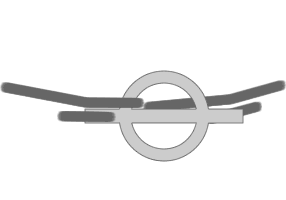
Both Lemond and Delgado seemed to me to push the pedal forward and then drag it down and back through the bottom dead spot with their toes pointing upwards. Compare their technique to that of Miguel Indurain or, more recently, Lance Armstrong. Both of these pedal with a huge range of ankle movement yet their toes point down through both dead spots.
Without wishing to denigrate Lemond and Delgado, I’ve yet to see anyone with a ‘toes up’ style of pedalling look as smooth or powerful, especially under pressure, as a good ‘toes down’ pedaller.
To my mind the perfect, smooth, pedalling technique looks like this animation from my pedalling page
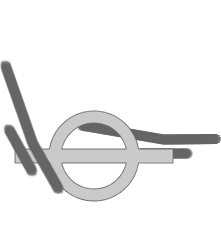
I think this is what the best pedallers look like and it’s what I try to do when I’m riding. It feels good to me and I was pleased to discover that when I finally got to try out some Power Cranks (see below) it felt good on those too.
I would describe this pedalling technique as Lift, Flick, Claw (LFC). It’s the absolute opposite of, er, mashing, or stomping, as the thing that you think about least is pushing down.
LFC Pedalling
If you try pedalling with one leg you’ll find that pulling the pedals up makes your leg tire very quickly. The muscles that lift your legs (your hip flexors) are small. You can train them to be stronger, but compared to the muscles that you can use to push the pedals (your quads, glutes, calves and hamstrings) they're always going to be tiny. What they exist for, and what they're good at, is lifting your knee - for walking, running, climbing, jumping, kicking and doubling up offensive men. What they can do very effectively when you're cycling is get your big, heavy leg out of the way of the pedal that's coming up.
The Lift is the recovery phase before the start of the next stroke. The Claw phase should ensure that the lift begins with the toes pointing down. The momentum from the Claw phase takes the pedal well through the bottom dead spot so propulsion (driving torque) is now being provided by the other leg. The lifting is done by the hip flexor. With the toes pointing down the rest of the leg is relaxed and there is very little tendency to apply downward pressure to the rising pedal. The lift phase doesn’t contribute to the stroke by applying forward torque – it contributes by not applying any backwards torque.
The Flick phase is the start of the new stroke. The muscle down the front of the shin (the Tibialis Anterior) flicks the toes forward through the top dead spot as the thigh starts to push down again. The speed of the flick, relative to the angular velocity of the crank, depends somewhat on the cycling conditions. Uphill, or into a headwind, where a continuous force is required the flick is extremely quick. Downhill, with a tailwind or in the middle of a bunch it can be much more leisurely.
The Claw phase begins as soon as the flick is completed and comprises a curved push combining continued downward acceleration of the knee with a forceful extension of the ankle. The objective is to apply a force tangential to the crank through the power phase of the stroke. This should result in a strong ankling motion culminating behind the bottom dead spot with the toes pointing somewhat downwards.

So why do I think that LFC is better than pushing over the top and dragging through the bottom?
- Dynamic Forces
Elsewhere on this site you’ll find my thoughts on position and the dynamic forces acting on the rider. Pushing the pedals forwards over the top (i.e. toes up) tends to result in pulling on the bars at the same time – unless you are pulling back equally hard with your bottom leg, which is unlikely. If you are pulling back hard you’ll be pulling against the spring in your pedals. The LFC method generates no resultant forward or backward force and the foot only 'pulls' against the spring during the recovery phase - i.e. it doesn't pull against the spring at all.
- Out of the saddle
The LFC action is exactly the same when riding out of the saddle. Instead of lifting your knees upwards, however, you should think about throwing them forwards, over your handlebars.
- No dead spots
Breaking the cycle into three sections, rather than two (push/pull), or four (down/back/up/forward), means that with both legs working there is no gap when neither leg is contributing.
- Encourages spinning
I find that LFC tends makes me accelerate by increasing my cadence rather than pushing harder. In road racing & triathlon, where minimising muscle fatigue for as much of the race as possible is likely to be significant, this has to be a good thing.
- Relaxed
Pinching a little from freestyle swimming the lift phase is similar to the arm recovery where the elbow (knee) is lifted high and the forearm, wrist & hand (lower leg, ankle and foot) hang freely with the muscles relaxed. The moment that road racing 'clicked' for me was when I discovered that if I released my vice-like grip on the handlebars, and relaxed my arms, my legs went round better. LFC is the most relaxed way that I've found of pedalling at speed.
Why not do what comes naturally?
This is the standard argument against trying to change any technique. It’s normally backed up with references to sporting greats with an odd or idiosyncratic style (Janet Evans, Paula Radcliffe, Michael Johnson, any number of African marathon runners, …and who would have dreamed up Francisco Mancebo’s cycling technique?). What’s not so well documented, however, is the number of athletes in all sports who fail to reach anything approaching their potential because they stick with a technique that limits their progress or leads to injury. Why should everyone naturally discover the technique that's ideal for themself? In many sports it's essential to learn the skills simply to take part, take part safely or to score points.
Cleat position
The biggest encumbrance to LFC is having your cleats in the wrong place. Conventional wisdom says that the pedal spindle must be under the ‘ball’ of the foot. This is because you apply the force through your big toe joint. Most people who ride a bike with flat shoes and platform pedals automatically use the correct part of the foot (unless they use their instep). The only people who use their toes are ladies who cycle with high heels. The problems start to arise with toe clips - especially when used in conjunction with trainers or running shoes. Often the shoes won’t fit into the toe clips and the you end up pedalling with your toes. It is almost impossible to Claw if the pedal spindle is in front of the power point. Instead you ‘Clutch pedal’ pedal.
Clutch pedal pedalling
Clutch pedal pedalling is the antithesis of Claw pedalling. When you press on the clutch pedal in the car your toes come up, your heel goes down and your knee locks out. This is exactly what tends to happen if you apply your pedalling force behind the pedal spindle. The pedal will rotate, your heel will drop, you will try to push the pedal down and away. Only the fact that the cranks won’t stretch stops your knee locking out. Compare these two movements: Clutch pedal on the left, Claw on the right.
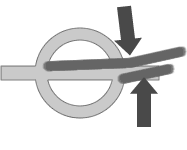
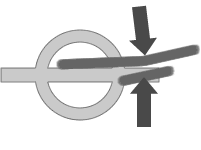
Beware the curse of cycling shoes and clipless pedals
The Clutch Pedal problem isn't restricted to big shoes and small toe clips.
Besides being 'small' old fashioned cycling shoes had very thin soles and the cleats were nailed on. The way to find where to put the cleats was to ride without them until the pedals made a mark on the sole. For all their benefits clipless pedals don’t allow this. Improvements in shoe technology led to hollow plastic soles with screw slots and sliding plates to allow adjustment. Somewhere along the line the soles became huge, thick, built up affairs with flat sections at the front. Worse still, some manufacturers started shaping the sole to ‘raise the heel’ (read what Steve Hogg has to say about the 'Windlass Mechanism' below).
The trouble with this is that many cyclists tend to feel most comfortable with their feet pretty much horizontal. Or rather they tend to pedal with their feet almost horizontal when the cranks are horizontal whether they like it or not. As diagram below attempts to show, a small change in foot position can result in a big change in where the force is applied. The spindle is indeed under the ball of the foot in fig 1 but as soon as the heel drops (fig 2) the ball moves behind the spindle and any further pressure will cause the heel to drop further. Clutch pedal, not Claw. The answer is to position the cleat further back, as in fig 3. The problem is that some cycling shoes do not permit this. (I spent a lot of money finding this out and have modified the soles of most of my cycling shoes to get my cleats in the right place)
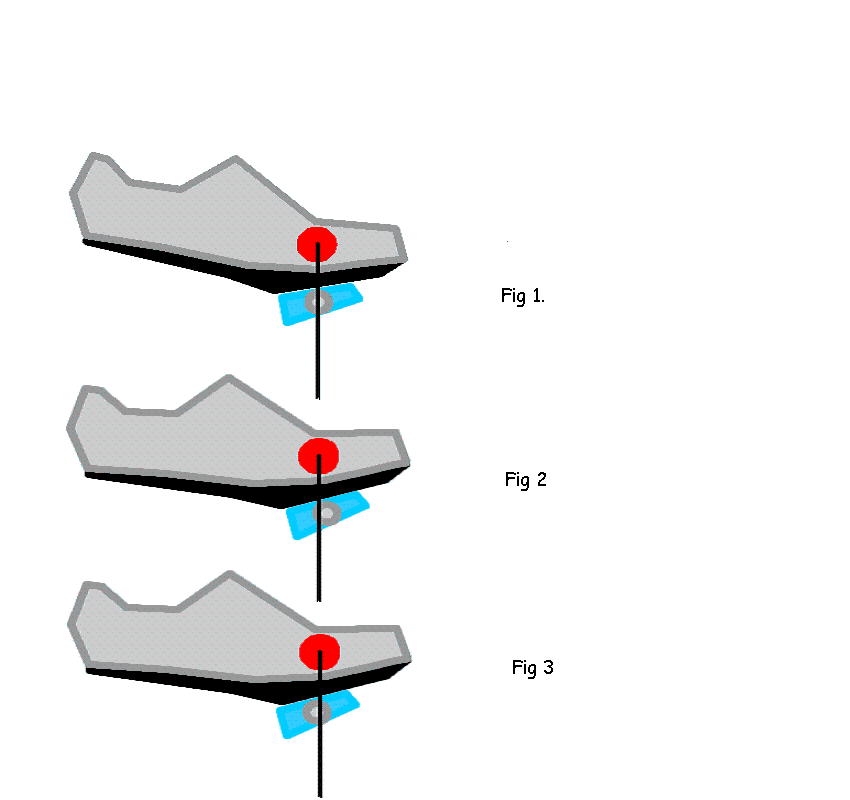
Newer cycling shoes, with thin carbon soles, seem to have reversed the trend but they still tend to have the cleat holes too far forwards.
The aforementioned Steve Hogg, who writes regularly for CyclingNews.com (see the Form and Fitness Q&A section), advocates locating the power point up to 12mm forward of the spindle. In most cases I agree with this though I’ve come across several people, mainly those from a (non-breaststroke) swimming background, whose natural foot position is quite extended. Also those with a relatively short torso, who therefore have their knees well forward of the pedal spindle, will probably find that they don’t need to do this.
I’ve taken the liberty of reproducing some of Steve Hogg’s pieces below
How to improve your pedalling
Besides setting your shoes up correctly there is not much to it other than awareness and concentration. Pedalling very slowly (rolling) is useful for developing ankle co-ordination and pedalling very fast (spinning) is useful for developing hip-flexor co-ordination – spin as fast as you can without bouncing in the saddle. The more relaxed you are, the faster you will be able to spin and the longer you will be able to sustain it. Try riding uphill in the big ring (without straining) and downhill in the little ring. Alternate between rolling & spinning on the flat or on the turbo.
Riding a fixed wheel bike is great for co-ordination, but only if you are forced to pedal fast. The benefit comes from lifting the rising leg.
Single leg pedalling is a useful drill though to really benefit try varying the gearing and your hand position. And don’t look down – that changes your body position completely. It’s very different turning a high gear with your hands on the tops from spinning a very small gear holding onto the drops or the tribars. And 30 seconds on each leg isn’t enough. Nor is 45. Short efforts will tell you whether you are actually able to lift the pedal – longer ones are required to develop the hip flexors. But build up carefully!
I’ve been fascinated by Power Cranks for many years but hadn’t tried them until 2004. See the Power Cranks website for (much) more information. If you haven’t come across them before they are independent cranks. Each crank drives the bottom bracket but not the other crank. This means that in order to pedal normally each leg has to take responsibility for its own recovery. It’s not quite like both legs doing one-leg pedalling as the recovering leg doesn’t need to contribute to the torque.
Tim Williams. November 2004
The following, by Steve Hogg, is reproduced from CyclingNews.com:
In most publications the advice given is to position the cleat fore and aft so that the centre of the first metatarsal joint [ ball of the foot] is over the pedal axle centre with crankarm and shoe forward and horizontal.
The idea, apparently, is to
1. Maximise the lever length of the foot as measured from metatarsal head to centre of ankle; and
2.To engage the 'windlass mechanism', the term used to describe plantarflexion of the ankle [ point foot down] accompanied by dorsiflexion of the toes [flex toes upwards] causing the tightening of the plantar fascia which turns the foot into more or less a rigid beam.
That reasoning makes sense in any quick reading but my experience is that it is way off the mark. Point 1 maximises the effective lever length of the foot but neglects the issue of control. If leverage is everything, then you and I should be able to hit a ball out of the ground with tip of the bat, because that point of contact maximises the lever length of the bat. If you have ever tried it you will know that it is not possible. All that happens is that you jar your wrists and elbows because we cannot fully control the movement. The greatest effective lever length of the bat is approximately 100mm up from the tip, the aptly named 'sweet spot'. And so it is with a foot on a pedal. By reducing lever length slightly we massively increase our ability to control the movement of it. Another factor in my view of this, is that many people are concerned about the amount of leverage they have on the crankarm and rightly so. But to many are hung up with quantifying this at the 3 o'clock position because this is the point of greatest leverage and hence torque development. No matter what parameters of seat and cleat position we set our self on a UCI legal bike this [give or take a fraction] will be where we exert greatest torque. So the question then becomes where can a rider make gains elsewhere in the pedal stroke. The major area in my view, where improvements can be made, is how soon after top dead centre can we get behind and over the pedal axle to propel it forward and down.
At that point, we all relative to individual technique, drop the heel more than elsewhere in the stroke under any reasonable load. If the ball of the foot is over the pedal axle as measured by the usual method, then at that point, the ball of the foot is BEHIND the pedal axle. If the ball of the foot is positioned the way I would do it, then at the same point in the pedal stroke, coming off top dead centre, then the ball of the foot would be OVER the pedal axle. This makes a big difference.
Point 2 is in my view, the misapplication of running / walking foot mechanics to cycling. I am convinced that the windlass mechanism is at work when we are riding OFF the saddle. I am equally convinced that the windlass mechanism is either not engaged or barely engaged when riding ON the seat, which is what we do the great majority of time spent on a bike. The question I would pose, is that if the windlass mechanism is strongly engaged when pedaling on the seat, then why does a rigid soled cycling shoe feel so much better than a more flexible soled cycling shoe. The answer that I would give is that the rigid sole is performing a function that the foot cannot.
I could go into more detail about the way most manufacturers have reduced the amount of heel lift in their shoes over the last 10 years [ this reduces the possibility of windlass mechanism engagement] but this should suffice.
--------------------------------------------------------------------
Here are Steve Hogg's recommendations for cleat positioning.
Shoe size 36 - 38: centre of ball of foot 7mm in front of pedal axle;
39 - 41: 8mm;
42 - 43: 9mm;
44 - 45: 10mm;
46 - 47: 11mm
48 - 50: 12mm.
There are a number of qualifiers that I will attach to those recommendations.
1. This info is for road and mtb riders. For general track riding, I would reduce the amount of foot over the pedal by a mm or 2 depending on shoe size and event. For sprinters and kilo riders, I would halve the recommended amount of foot over the pedal.
2. If positioning someone in person, I might vary the above a mm or so either way depending on other factors.
3. For riders with an exceptional heel dropping pedalling style, I would increase the amount of foot over the pedal slightly. The converse is true for the exceptional toe down style pedallers. For both groups I'm talking about technique under moderately severe load, not cruising in a small gear pedalling fast.
4. For riders with a lot of heel lift in their shoe last, I would increase the amount of foot over the pedal slightly.
5. For riders with flexible soled shoe, I would increase the recommendation slightly as with this type of shoe the heel deflects downwards more under load.
